This was published 1 year ago
Singapore's greenscraper hotels: The best green stays in Asia's greenest city
By Anthony Dennis
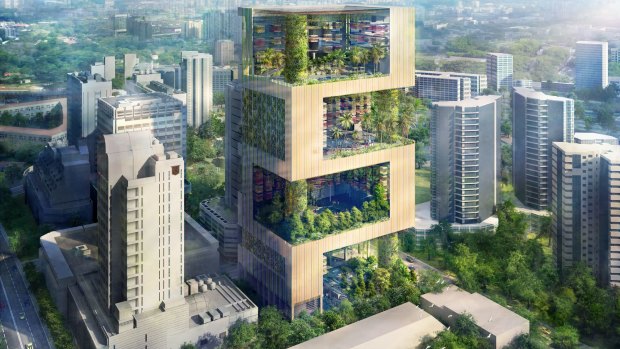
An artist's impression of the new Pan Pacific Orchard Hotel, designed by the Singaporean-Australian architectural firm, WOHA, and set to open in 2023.
I'm in the back seat of a Singaporean taxi, weaving my way through the slender, lolly-coloured shophouse-lined backstreets of Tanjong Pagar, when I ask myself, as you do, can sustainability really be sexy, even, wait for it, fun?
A peculiar thought, to be sure, but allow me to explain. As the typically Singapore spotless cab negotiates a corner and lines up on a broader main thoroughfare, the answer is, yes, well, probably. Ahead of me, through the driver's windscreen, I spot my accommodation for the next few nights.
No ordinary digs this, it's the biophilic 314-room Oasia Downtown, towering, startlingly so, above the scrimmages of those surrounding low-rise amber tile-topped heritage shophouses, like an incongruous gigantic raised green thumb in the middle of Asia's greenest city.
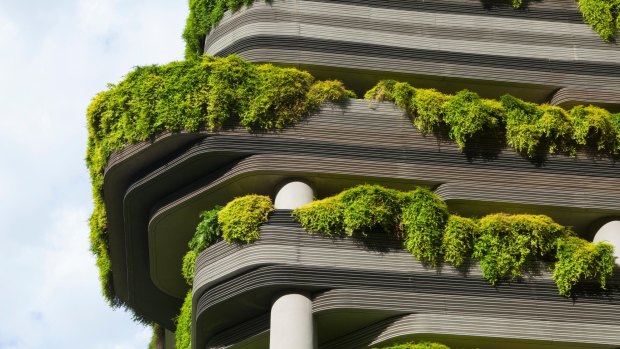
Considered to be the world's first "hotel in a garden", is the 16-storey vegetation enveloped Parkroyal Collection Pickering hotel.Credit: Simon Meaker / Alamy
This four-star hotel and office complex, designed by WOHA, the innovative Singaporean-Australian architectural firm, is one of the new generation of Singapore's bold living, breathing vertical gardens. Much of its 27-storey facade is covered, a little like an architectural three-day growth, in 21 species of climbing tropical creepers.
Forty per cent of the building consists of communal green open-sided spaces, including swimming pools and plant-fringed recreational areas, tall cutaway sections high above Singapore. No mechanical ventilation is required for Oasia Downtown rooms or offices because of those open-sided sky gardens and Singapore's annual 2200 millimetres of rainfall supplying plentiful water to irrigate the plant life.
Paradoxically, Oasia Downtown replaced a park but, crucially and rather astoundingly, the building now provides about 10 times the greenery of that original site.
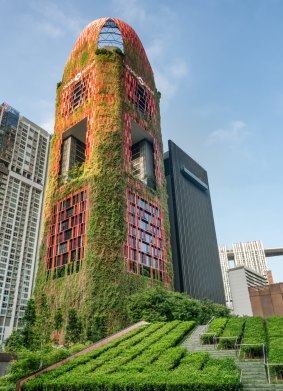
Singapore's Oasia Downtown hotel, one of the island's state's new brand of eco-minded greenscrapers. Photo: supplied
With the hotel operating on the upper levels of the building, with warm breezes wafting through its sheer open sides and surrounded by tropical foliage, it feels, rather delightfully, like you've landed in a vertical island resort, sans the lapping waves and coconut trees.
So proud is Singapore of its green buildings such as this one that it even issued "Skyrise Greenery", a series of stamps (the tallest ever) last year to recognise six of the best examples of its green architecture including the Jewel, the grandiose nature-themed entertainment and retail complex at Changi Airport and, yes, Oasia Downtown.
Like many of us these past two years, I've been drawn closer to nature with the pandemic allowing you pause to properly appreciate that which surrounds us.
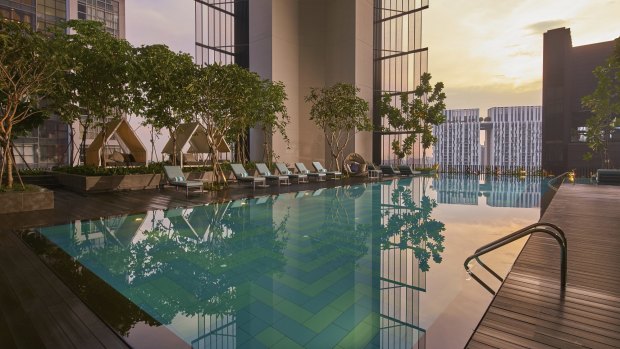
Singapore's Oasia Downtown sticks out like an incongruous gigantic raised green thumb.
Although I've stayed at another of Singapore's green hotels, the groundbreaking Parkyroyal on Pickering (see below and a notable omission from those six stamps) and visited the outlandish Jewel, on my countless occasions here I've never properly sought out its pervasive natural side. Until now, that is, and much as I'd like to linger, Oasia Downtown, is to be an appropriate base from which to more fully discover the burgeoning green side of Singapore.
THE RUSH FOR LUSH
Far from being a recent reaction to climate change, Singapore's garden city vision was conceived way back in 1967 by its autocratic founding father Lee Kuan Yew. Singapore would be "a garden city beautiful with flowers and trees and as tidy and litterless as can be," he declared.
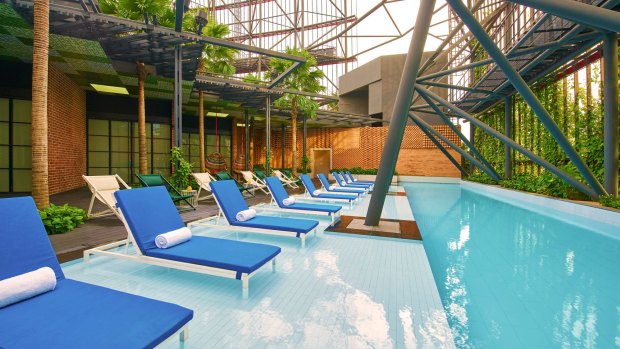
Much of Oasia Downtown's 27-storey facade is covered in 21 species of climbing tropical creepers.
Of course, Lee's neatness fetish would extend not only to short back and side haircuts for men and a ban on chewing gum but a widespread perception of Singapore as a bland place (but that's another story).
While guilty of bulldozing too much of the city's unique colonial built heritage and stopping just in time to come to their senses, Lee and his cohort realised that rapid economic development would need to be combined with social or environmental sustainability in the form of abundant greenery.
In time, it would signify Singapore's investment and tourism-friendly Swiss-via-south-east Asia like efficiency with Lee and his successors eventually proving that a concrete jungle can not only co-exist with a natural jungle, or what remained of it, but also successfully integrate with it.
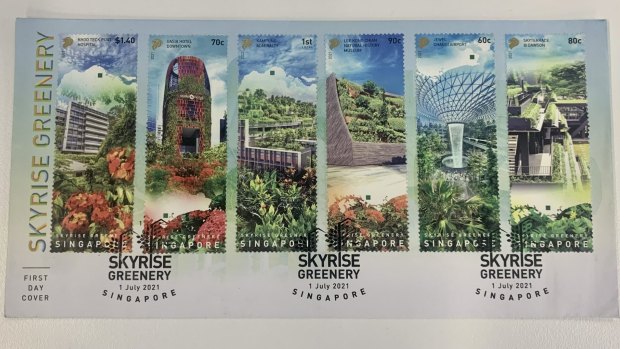
The city issued a series of stamps last year to recognise six of the best examples of its green architecture.
Nearly six decades later, a tourist like me can stay at a vertical garden like Oasia Downtown or even, on the other side of town, the vast eco-tinged Marina Bay Sands integrated resort complex with its triumvirate of towers topped off by a platform, extending across all three structures, big enough to host a quartet of A380s parked side-by-side.
It's there that the towers' guest room balconies are draped with lavish flourishes of pink Bougainvillaea. (Elsewhere in Singapore, footbridges over freeways and even elevated freeway supports get similar beautifying touches).
It's even possible for house guests like myself to take their own self-guided sustainability tour of Marina Bay Sands, downloadable from its website. It takes in its RISE Herb Garden, featuring 70 edible plants grown and harvested for its restaurants, its rooftop garden, which absorbs heat and provides insulation and Rain Oculus, a spectacular, if sculptural effect which collects and recycles rainwater for "bathroom flushing", among other purposes (it's more fun than it may sound).
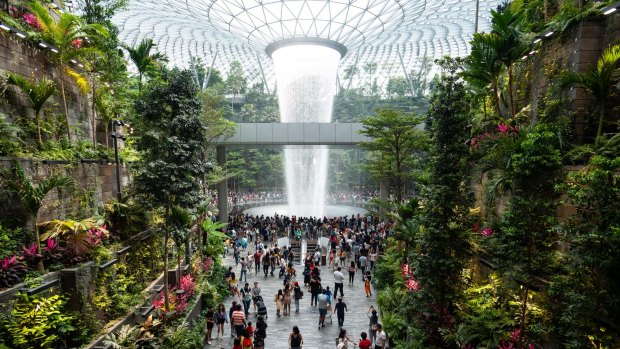
The Jewel offers a ground-breaking nature-themed entertainment and retail complex at Changi Airport.Credit: Olaf Schuelke / Alamy
All of this and more, is directly and indirectly, the product of a remarkable Singaporean initiative. Introduced in 2009, it was appropriately christened LUSH (Landscaping for Urban Spaces and High-Rises).
As Richard Hassell, WOHA's Australian-born co-founding director explains, LUSH was designed to "incentivise developers to include ample greenery in their projects in order to reintroduce nature and biodiversity back into Singapore's high-density, high-rise urban environment".
"LUSH has been very successful and is a good example of how the government has been able to mobilise the private sector to contribute to its vision for Singapore to be a 'City in Nature'," says Hassell, whose firm also designed Singapore's ambitious country pavilion at the recent World Expo in Dubai urban.
A verdant tropical revelation in the midst of its desert setting, the net-zero energy pavilion explored Singapore's journey towards "liveability and resilience" and featured an "immersive three-dimensional greenery experience" including a net-zero "energy rainforest powered by a self-sustaining ecosystem".
Hassell says that cities like Taichung in Taiwan and even Brisbane in a climate change recalcitrant Australia are now replicating the Singapore model, revising their own building regulations to increase the amount of green spaces in the city.
WOHA sees its own "hospitality projects", such as Oasia Downtown and other like-minded projects in Singapore, "as laboratories for future lifestyles".
"They are great for us to develop ideas of what future daily life would be like: sociable, green, highly liveable. We manage to integrate green strategies into every project, from the adaptive reuse of a small heritage Singaporean shophouse to large-scale projects."
The Singaporean green building ethos, which also encompasses hospital complexes, residential developments and tertiary institutions, is certainly taking root. A new Four Seasons hotel, planned for Melbourne's Southbank precinct, will form part of the world's tallest vertical garden.
The 210-room Four Seasons, swaddled in vegetation, will start on the 63rd floor of the 275-metres high western tower of the complex. Until it's completed, and that will be years away, we still have Singapore.
"Singapore offers so many varieties of equatorial tropical landscapes from tidal, mangrove forests to rewilded secondary rainforests that are open to the public," says Hassell.
"It's a unique combination of high-density urban spaces with nature. The government has moved on from the 'City in a Garden' concept to its 'City in Nature' vision and is implementing strategies like the LUSH program and the park connector network."
MAKING GREEN WAVES
The park connector network, to which Hassell refers, is a plan to link all the green spaces of the city so that they can be more readily accessed and enjoyed by ordinary Singaporeans and by the few tourists aware of them.
One of the best, if not most spectacular places to discover this side of the Singapore is Henderson Waves, hovering above the jungle like a twisted snake, in an area known as the Southern Ridges in the south of the island. The 274-metres pedestrian-only walkway, crafted from balau, a dense hardwood, features prominently in Singapore Airlines' uncommonly serene and beautiful in-flight safety video.
From here you can launch into a walk, nay hike, what with Singapore's two-shirt–a-day humidity, straight into the military green forests nearly 40 metres below, tramping up and across the paved paths takes you all the way down to the green island playground Sentosa connected by cable car from Mount Faber Peak.
Halfway or so along the walk there's a series of artworks depicting key moments in Singapore history including the humiliating surrender of the British to the Japanese in World War II.
Further on, atop Faber Point, there's a prouder-looking, three-metres high polymarble white merlion, a creature with the body of a lion and a fish drawn not from mythology but from the imagination of a tourism marketer.
From here I plunge back into a jungle-like forest section of the Marang Trail and eventually out onto a busy road near the entrance of Sentosa Island.
Several thousands of steps later, by the time I stumble, live and sweaty, into the lobby of Oasia Downtown, I look like I've been in a tropical downpour that never occurred but it's been worth it, even though I nearly need a chisel to remove my Clag-like shirt back in my room.
Over the coming days on my Singapore green quest, I'll perspire my way through visits to the Singapore Botanic Gardens, the outlying island of Pulau Ubin and the new Rail Corridor (see panel).
REACH FOR THE SKYGARDENS
Back in central Singapore and not far from Oasia Downtown is another groundbreaking WOHA-designed building, considered to be the world's first "hotel in a garden", the 16-storey vegetation enveloped Parkroyal Collection Pickering hotel.
I stayed there on a previous visit before the pandemic and while it opened in 2013 it still feels secateur sharp, being one of the first hotels to ban the use of plastic drinking straws and eschew laundry and dry-cleaning delivered to rooms in clear wrapping.
It's composed of 15,000 square metres of cooling greenery, constituting twice the total land area of the hotel and encompassing 50 varieties of plants swathing the hotel's concrete facade. Like Oasia Downtown, they form the building's lush "sky gardens", with the lavish vegetation complemented by reflecting pools and ornamental waterfalls.
The sequel to Parkroyal Collection Pickering by Hassell and co is the arresting 23-storey Pan Pacific Orchard, touted "as the latest showcase of environmental sustainability of this green city featuring the dramatic biophilic signature of WOHA."
The 350-room eco-friendly Pan Pacific Orchard, located, as the name suggests, along Singapore's most well-known shopping strip, will include, get this, four differently themed interiors, namely forest, beach, garden and cloud. WOHA calls it "high-rise tropical hospitality."
The Forest Terrace will feature a water plaza and cascades and edged by forest-style trees; the Beach Terrace, a tropical oasis, with "meandering sandy beachfront" and palm groves around an emerald lagoon; the Garden Terrace a manicured garden, complete with verandah, lawn, fountains and garden; and finally, the Cloud Terrace with thin mirror pools and filigree planting, washed by natural light filtering through the photovoltaic roof canopy.
Now that's sexy.
FIVE EASY-TO-EXPLORE SINGAPORE GREEN SPACES
PULAU UBIN
An outlying island to the main landmass, Pulau Ubin is not only a popular escape for nature-loving Singaporeans it also offers a rare glimpse of the island state's pre-independence. Don't miss Butterfly Hill and its colourful inhabitants and the isle's ramshackle kampong-style waterfront stilt houses. See visitsingapore.com
SINGAPORE BOTANIC GARDENS
Singapore's superb World Heritage-listed Botanic Gardens, opened in 1859, are often overlooked in favour of the contemporary Gardens by the Bay (see below). Before plunging into the Botanic Gardens' immense and manicured greenery, breakfast at Bees Knees cafe set in a colonial-era building. See nparks.gov.sg
GARDENS BY THE BAY
Opened in 2012, Gardens by the Bay, "a horticultural oasis of lush greenery and floral displays", consists of two cathedral-sized conservatories as well as a 22-metre high suspended walkway surrounded by towering fantastical man-made Supertrees entangled in vegetation. See gardensbythebay.com.sg
FORT CANNING PARK
Once home to Malay royalty and the site of Sir Stamford Raffles' first governor lodgings, historic Fort Canning Service Reservoir includes Battlebox, a British underground command centre bunker used during World War Two, where guided tours are held. See visitsingapore.com
THE RAIL CORRIDOR
Singapore's newest green project is the 24-kilometre-long Rail Corridor. Opened last year, a four-kilometre stretch features restored landmark bridges and decommissioned stations. The tree-lined track once served as a goods and passenger line between Singapore and the Malay peninsula. See nparks.gov.sg
FIVE GREEN SPOTS RICHARD HASSELL LOVES
BUKIT TIMAH RESERVE
Only 12 kilometres from the centre of Singapore, the 163-square kilometres Bukit Timah Reserve is home to a high proportion of the island's native flora and fauna as well one of the nation's few surviving areas of primary rainforest. See nparks.gov.sg
MACRITCHIE RESERVOIR
The site of Singapore's largest reservoir, MacRitchie includes Treetop Walks, a 250-metre free standing suspension bridge spanning the two highest points within the park as well as an 11-kilometre nature trail. Look out for long-tailed macaque monkeys, squirrels and monitor lizards. See visitsingapore.com
LABRADOR NATURE RESERVE
A habitat of birdlife such as oriental magpie-robin and the black-naped oriole, as well as the island's abundant squirrels, nature-loving Singaporeans flock here for strolls along the reserve's nature trails. Labrador also includes the only rocky sea-cliff on the country's main island. See nparks.gov.sg
SUNGEI BULOH WETLAND RESERVE
A site of international importance for migratory birds. Sungei Buloh consists of 202 hectares of mangroves, mudflats, ponds and forests. Easily reached by public transport, there's a new visitor centre and nature trails for visitors to explore. See nparks.gov.sg
DAIRY FARM NATURE PARK
This 75-hectare park is known for the Wallace Education Centre featuring a permanent exhibition dedicated to the renowned English naturalist Alfred Russel Wallace. In the mid 19th century, Wallace used Singapore as a base to study the natural history of the Malay Archipelago. See visitsingapore.com
FIVE MORE GREEN CITIES
COPENHAGEN, DENMARK
In Copenhagen, many citizens favour cycling over fossil-fueled vehicle usage for transport, with only 29 per cent of households owning a car. It's helped make the Danish capital the first CO2 neutral city. See visitcopenhagen.com
VIENNA, AUSTRIA
Half of the Austrian capital's total area consists of green spaces, a higher proportion than any other European city. It also leads in conservation, wastewater management, clean air and water, public transportation and single use. See wien.info
VANCOUVER, CANADA
Ninety-five per cent of Vancouver's electricity today comes from renewables and it's credited with the lowest per capita greenhouse gas emissions of any major city in North America. It's also built sustainable transport and invested in highly energy-efficient buildings. See destinationvancouver.com
BERLIN, GERMANY
Thanks to its extensive cycling and walking network, Berlin ranks among the most pedestrian-friendly and greenest cities. Berlin, with its low level of car ownership, has acted to foster clean air, divestment from fossil fuels, and reintroduce nature to its green spaces. See visitberlin.de
CURITIBA, BRAZIL
Home to the Free University for the Environment, Curitiba's citizens receive food and tokens to the city's rapid bus system in exchange for utilising the city's recycling program. Since the 1970s, the city of two million has planted more than 1.5 million trees and opened dozens of public parks. See turismo.curitiba.pr.gov.br
AMSTERDAM, NETHERLANDS
A capital for bicycling long before cycling became fashionable and, for that matter, sustainable, Amsterdam aims to reduce its emissions by 55 per cent by 2030 and 95 per cent by 2050 and become 100 per cent single use (or fully circular). See iamsterdam.com
Source: sustainabilityjungle.org
THE DETAILS
FLY
Singapore Airlines now operates 28 flights per week between Sydney to Singapore and 21 services weekly between Melbourne and Singapore. Earlier this year the airline announced ExxonMobil as the supplier of sustainable aviation fuel (SAF) as part of a pilot on the use of SAF in Singapore. The fuel is produced from used cooking oil and waste animal fats and blended with refined jet fuel at ExxonMobil's facilities in Singapore. The use of the SAF over the one-year pilot is expected to reduce about 2500 tonnes of carbon dioxide emissions. See singaporeair.com
STAY
Rooms at Oasia Downtown start from $S210 ($206) a night. 100 Peck Seah Street. Phone +65 6881 8888, see oasiahotels.com
Rooms are Marina Bay Sands start from $S439 ($430) a night. 10 Bayfront Avenue. Phone 65 6688 8868, see marinabaysands.com
HEALTH
At the time of writing, Australians visiting Singapore are subject to a series of COVID-19 regulations including documentation showing full vaccination status, travel insurance and proof of a negative pre-departure test within two days of departure to Singapore. Within 24 hours of arrival to Singapore, an "unsupervised, self-administered, self-procured authorised [COVID-19] test" is required. These rules are subject to change. For full information, details and updates, see safetravel.ica.gov.sg
MORE
Anthony Dennis visited Singapore as a guest of Singapore Airlines and Oasia Downtown and Marina Bay Sands.
Sign up for the Traveller Deals newsletter
Get exclusive travel deals delivered straight to your inbox. Sign up now.